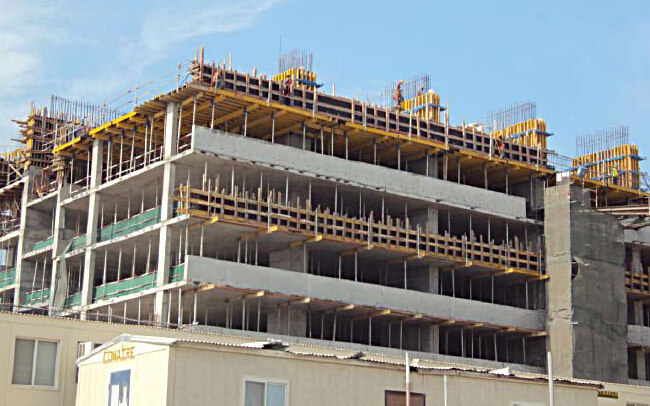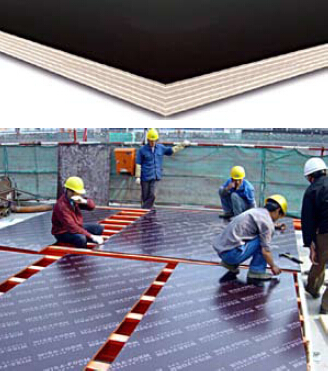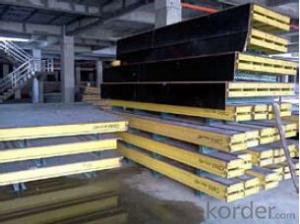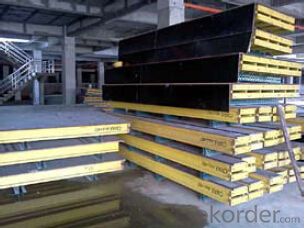Plywood Formwork system for formwork and scaffolding
- Loading Port:
- Tianjin
- Payment Terms:
- TT OR LC
- Min Order Qty:
- 50 m²
- Supply Capability:
- 1000 m²/month
OKorder Service Pledge
Quality Product, Order Online Tracking, Timely Delivery
OKorder Financial Service
Credit Rating, Credit Services, Credit Purchasing
You Might Also Like
Plywood --- make perfect concrete surface
WISA-Form Birch is a coated special plywood using in the formwork systems where high
requirements are set on the concrete surface and the times of reuses.
With CNBM timber beam & WISA plywood, the formwork is low weight but high load capacity, it is
widely used in construction.
Characteristics:
◆ Component with high standardization.
◆ Assembling in site, flexible application.
◆ Light weight, easy transportation and storage.


- Q: What are the different transportation and storage requirements for steel formwork?
- Steel formwork, being a heavy and durable material, requires specific transportation and storage requirements. For transportation, it is crucial to have suitable vehicles with sufficient carrying capacity to accommodate the weight of the steel formwork. Additionally, proper securing and fastening mechanisms should be employed to prevent any movement or damage during transportation. Regarding storage, steel formwork should be kept in a dry and well-ventilated area to prevent corrosion. It is essential to protect the steel formwork from exposure to moisture, extreme temperatures, and direct sunlight, as these factors can deteriorate its quality. Furthermore, proper stacking methods and supports should be utilized to prevent any deformation and ensure the longevity of the steel formwork.
- Q: Types of building templates? What is clear water template?
- Steel template: in addition to the combination of steel templates, has developed a wide steel template, all steel large formwork, light steel mold, 63 steel frame steel template. The high cost of steel mold, in addition to large projects such as bridges or other buildings, nuclear power plants, reservoirs and other construction sites, has been replaced by building wooden template.
- Q: What are the different types of connections used in steel formwork construction?
- Steel formwork construction utilizes various types of connections, each serving a specific purpose. 1. Bolted connections, the most commonly used type, involve securing steel formwork components together using bolts, nuts, and washers. This connection provides a strong and rigid joint that is easy to assemble and disassemble. 2. Welded connections fuse steel formwork components together using heat and pressure. They are ideal for permanent structures or situations requiring high strength and rigidity. However, welded connections are time-consuming and require skilled labor. 3. Clamped connections utilize clamps or brackets to hold steel formwork components together. This connection type is suitable for temporary structures or frequent disassembly/reassembly, as it is quick to assemble and disassemble and does not require specialized skills or equipment. 4. Interlocking connections employ specially designed mechanisms, such as tabs, slots, or grooves, to connect steel formwork components. These connections are commonly used in modular formwork systems, where fast and easy assembly is necessary. 5. Adhesive connections involve bonding steel formwork components together using epoxy or other adhesive materials. This connection type provides a seamless and smooth joint, often used for architectural or decorative purposes. Proper surface preparation and curing time are essential for achieving maximum strength. In summary, the choice of connection type in steel formwork construction depends on factors such as desired strength and rigidity, structure type, reusability, and available resources and expertise. It is crucial to select the appropriate connection type to ensure the safety and stability of the formwork system.
- Q: What are the considerations when designing steel formwork for tunnels?
- When designing steel formwork for tunnels, there are several important considerations that need to be taken into account. Firstly, the structural integrity of the formwork is crucial. The steel formwork needs to be able to withstand the forces exerted by the surrounding soil and the weight of the concrete being poured. It should be designed to be strong enough to prevent any deformation or collapse during the construction process. Secondly, the dimensions and shape of the tunnel need to be carefully considered. The formwork should be designed to match the exact dimensions and curvature of the tunnel to ensure a precise fit. This will help to ensure that the final concrete structure is of the correct size and shape. Thirdly, the formwork needs to be designed in a way that allows for easy installation and removal. This is particularly important in tunnel construction, where access can be limited and space is often restricted. The formwork should be designed to be easily assembled and disassembled, with minimal disruption to the construction process. Another consideration when designing steel formwork for tunnels is the surface finish of the concrete. The formwork should be designed to provide a smooth and even surface, as any imperfections or irregularities in the formwork can be transferred to the concrete. This is important for both aesthetic reasons and to ensure the structural integrity of the final concrete structure. Lastly, the formwork should be designed in a way that allows for proper ventilation and drainage. Tunnels can be prone to moisture accumulation, which can lead to corrosion and deterioration of the steel formwork. Proper ventilation and drainage systems should be incorporated into the design to prevent any moisture-related issues. In conclusion, when designing steel formwork for tunnels, it is important to consider the structural integrity, dimensions and shape, ease of installation and removal, surface finish, and ventilation/drainage requirements. By carefully addressing these considerations, the design of the steel formwork can be optimized to ensure a successful and efficient tunnel construction process.
- Q: How does steel formwork affect the cost of construction?
- Steel formwork can have a significant impact on the overall cost of construction. While it may require a higher initial investment compared to traditional formwork materials such as wood or plywood, steel formwork offers several advantages that can help offset the increased cost. Firstly, steel formwork is incredibly durable and long-lasting, which means it can be reused multiple times. Unlike wood or plywood formwork, steel formwork does not warp, rot, or degrade over time. This reusability factor reduces the need for frequent formwork replacements, thus saving on material costs in the long run. Additionally, steel formwork provides superior strength and stability, allowing for the construction of complex and high-quality concrete structures. This strength enables the use of thinner formwork elements, reducing the overall weight of the formwork system. As a result, less labor and equipment are required for handling and installation, leading to cost savings in terms of manpower and machinery. Furthermore, steel formwork allows for faster construction cycles. The smooth and precise surface finish provided by steel formwork reduces the need for extensive finishing work. This streamlined construction process saves time, ultimately reducing labor costs and project timelines. Moreover, steel formwork offers enhanced safety on construction sites. Its sturdy nature and secure connections ensure stability during concrete pouring and curing, minimizing the risk of accidents or structural failures. This improved safety aspect can help in reducing insurance costs and potential legal liabilities. Lastly, steel formwork is highly adaptable and customizable. It can be easily modified and adjusted to accommodate various design requirements, making it suitable for a wide range of construction projects. This flexibility helps optimize material usage and ensures minimal wastage, thereby reducing overall construction costs. In summary, although steel formwork may initially incur a higher cost, its long-term benefits such as reusability, strength, speed, safety, and adaptability contribute to overall cost savings in construction projects. Its durability and efficiency make it a cost-effective choice that can positively impact the quality, timeline, and budget of any construction undertaking.
- Q: Are there any specific safety guidelines for steel formwork installation?
- Steel formwork installation requires adherence to specific safety guidelines. The following key safety measures should be observed: 1. Training and Competency: All personnel involved in steel formwork installation must undergo proper training and possess the necessary skills. This includes knowledge of equipment, understanding of installation procedures, and awareness of potential hazards. 2. Personal Protective Equipment (PPE): Workers must wear appropriate PPE, including hard hats, safety glasses, gloves, and steel-toed boots. This is to protect against potential head, eye, hand, and foot injuries. 3. Inspection and Maintenance: Regular inspections should be conducted on the steel formwork and associated equipment to identify any defects or hazards. Immediate repairs or replacements should be carried out for damaged or faulty parts to ensure safety during installation. 4. Hazard Identification and Control: Before commencing installation, a comprehensive assessment of the work area must be performed to identify potential hazards, such as overhead power lines, uneven ground, or confined spaces. Adequate measures, like erecting barriers, using warning signs, or implementing fall protection systems, should be taken to control these hazards. 5. Manual Handling: Proper lifting techniques should be employed to prevent back injuries or strains. For heavy or awkward loads, the use of mechanical aids such as cranes or hoists should be considered. 6. Fall Protection: Due to the inherent risk of falls during steel formwork installation, especially when working at heights, the use of adequate fall protection systems, such as guardrails, safety nets, or personal fall arrest systems, is essential to prevent accidents and safeguard workers. 7. Communication and Coordination: Clear communication and coordination among the installation team are crucial for a safe installation process. Regular safety briefings, ensuring clear understanding of roles and responsibilities, and maintaining an open line of communication for reporting safety concerns are essential. It is important to note that these guidelines may vary depending on the specific project, local regulations, and industry standards. Therefore, it is advisable to consult with relevant authorities, such as the project engineer or site safety officer, to ensure compliance with all necessary safety requirements.
- Q: Can steel formwork be customized for different project requirements?
- Yes, steel formwork can be customized to meet different project requirements. Steel formwork is known for its versatility and flexibility, making it suitable for a wide range of construction projects. It can be easily adjusted and modified to accommodate various dimensions, shapes, and designs. Customizing steel formwork involves making alterations to its size, shape, and configuration to fit specific project requirements. This can be done through cutting, welding, and bending the steel sheets or frames to the desired specifications. Steel formwork can be easily modified on-site or in a workshop, allowing for quick adjustments and adaptations as necessary. Furthermore, the use of steel formwork allows for the creation of complex and intricate structures. It can be easily molded and shaped to meet unique project demands, including curved or irregular surfaces. Steel formwork can also be combined with other materials such as plywood or timber to enhance its versatility and further customize it to specific project requirements. In summary, steel formwork can be customized to cater to different project requirements due to its inherent flexibility and adaptability. Its ability to be modified and adjusted allows for the creation of diverse structures, making it a popular choice in the construction industry.
- Q: What are the safety precautions when using steel formwork?
- When using steel formwork, it is important to follow a few safety precautions. Firstly, ensure that the formwork is properly inspected and maintained before use to identify any potential hazards or structural weaknesses. Secondly, use appropriate personal protective equipment, such as gloves and safety glasses, to protect yourself from injuries. Additionally, make sure to handle the steel formwork properly, using proper lifting techniques and avoiding overloading. Lastly, ensure that the work area is properly secured and stable to prevent accidents or collapses.
- Q: New building formwork support is all steel
- The shear wall formwork support combination device is composed of a shear wall formwork support assembly device, which is composed of a cross beam, a vertical beam, a positive angle, a negative angle, a top pull rod, a door card, and a wall screw arch fitting. [] with the thickness of the vertical beam forming 2.75mm cold-rolled steel plate, welded by the jacket, Easter, Liang Xin. The structure and properties of the same column template support vertical beam structure. The cross beam is composed of an outer casing, a beam core, a movable joint, an outer sleeve and a beam core which are provided with a rectangular hole which is used for adjusting the size of the through wall screw
- Q: Can steel formwork be used in tunnel construction projects?
- Yes, steel formwork can be used in tunnel construction projects. Steel formwork is known for its durability, strength, and ability to withstand high pressure and heavy loads. It can be easily assembled and disassembled, making it suitable for tunnel construction where repetitive use is required. Additionally, steel formwork provides a smooth surface finish and allows for precise shaping and molding of concrete, ensuring the structural integrity of the tunnel.
Send your message to us
Plywood Formwork system for formwork and scaffolding
- Loading Port:
- Tianjin
- Payment Terms:
- TT OR LC
- Min Order Qty:
- 50 m²
- Supply Capability:
- 1000 m²/month
OKorder Service Pledge
Quality Product, Order Online Tracking, Timely Delivery
OKorder Financial Service
Credit Rating, Credit Services, Credit Purchasing
Similar products
Hot products
Hot Searches
Related keywords



















